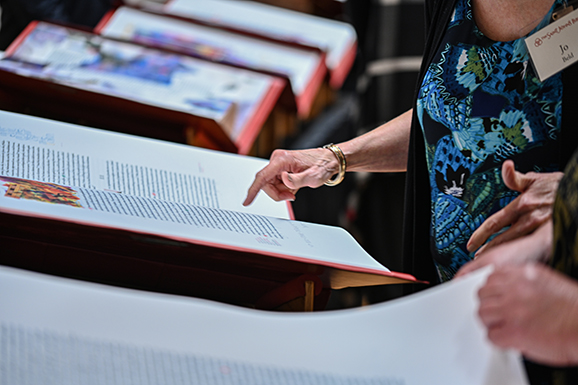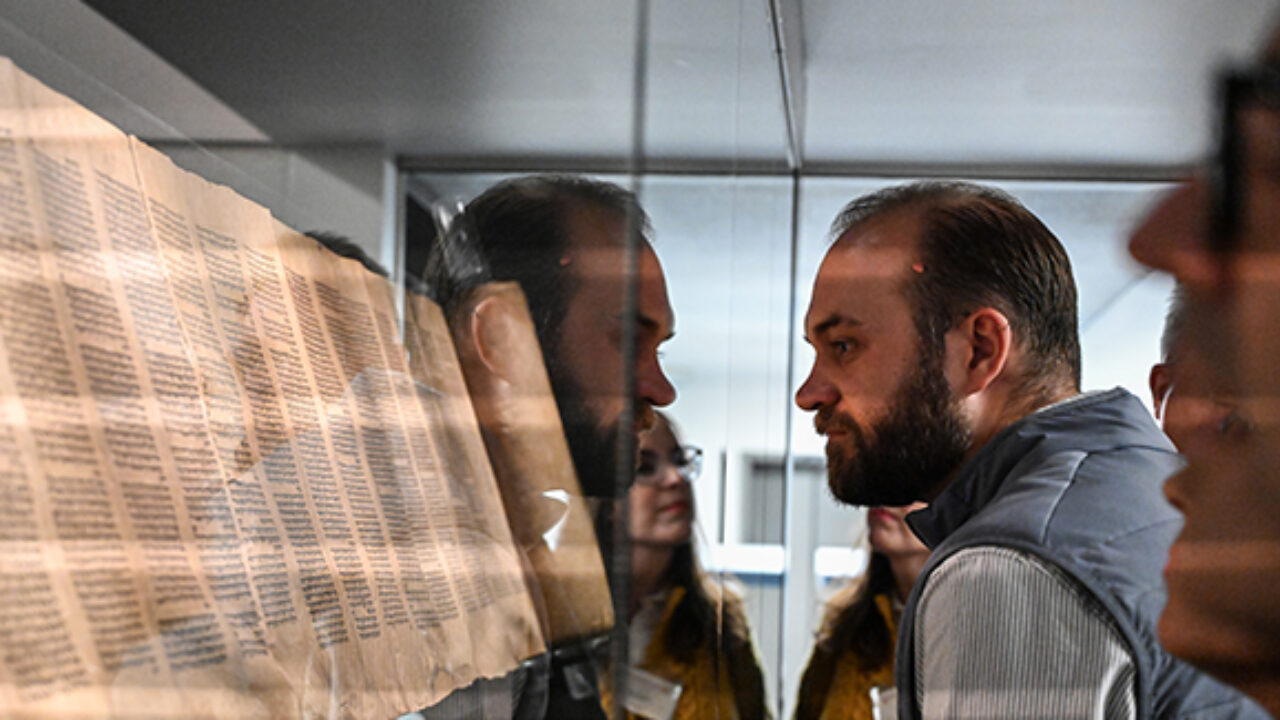St. Olaf College Shows Us What Interfaith Education Really Means on a College Campus
St. Olaf College, which welcomed a Heritage Edition of The Saint John’s Bible to campus in September 2024, plans to acquire two additional sacred texts for use in academic study and spiritual nurturance and exploration.
Northfield, Minnesota
Over the past several decades, but in recent years especially, religiously affiliated colleges and universities across the United States have grappled with an important question: How can we remain rooted in the Christian tradition while honoring and engaging the religious traditions of all students and faculty on campus?
St. Olaf College in Northfield, Minnesota, is one college in pursuit of this mission. The College was founded in 1874 by a group of Lutheran, Norwegian American pastors, farmers, and business people. Over time, the religious affiliation of students has grown more diverse. As of 2024, 16% of students identify as Lutheran, 18% as other Protestant, 12% as Roman Catholic, 4% as other Christian, 6% as other faith tradition (Muslim, Hindu, Buddhist, etc.), 31% as no affiliation, and 13% as unknown.
Acknowledging this growing diversity in religious practices and curiosities on campus, the College established the Lutheran Center for Faith, Values, and Community in 2019. The Center aims to provide “opportunities for students, faculty, staff, and alumni to connect with each other around questions of belief, meaning, purpose and life choices,” according to the College’s website.
These opportunities come in many forms, such as hosting a student congregation with Lutheran worship each Sunday (and chapel five days a week), guiding students through the Lutheran concept of exploring meaningful vocation, and implementing vast programming surrounding the question: What does it mean to be Lutheran?

While the Center is rooted in Lutheranism, it also actively encourages “the interreligious exploration of faith, values, and vocation.” Through the Lutheran Center, the College has implemented programming such as the interreligious circle, a group of students of all religious backgrounds that meet biweekly to explore how their different religious identities impact how they perceive and imagine the world. The Center also offers interfaith fellowships and internships to students in pursuit of interreligious spiritual and academic nourishment.
St. Olaf’s College Ministry team has also grown in recent years, adding both an Associate Chaplain for Jewish Life and an Associate Chaplain for Muslim Life in 2019. In 2024, the team welcomed Rav Michaela Brown as Associate Chaplain for Jewish Life, following the retirement of Rabbi Shosh Dworsky. The College is in the process of recruiting a new Associate Chaplain of Muslim Life.
So, when two former St. Olaf Regents, Timothy Maudlin and Tad Piper, and their families brought forth the idea of welcoming a Heritage Edition of The Saint John’s Bible to campus, it didn’t take long at all for that idea to open up a whole realm of possibility for interfaith representation and exploration.

The idea initiated a “period of discernment,” according to Vice President for Mission at St. Olaf College, Dr. Jo M. Beld. The pinnacle of this period of discernment was convening a large group of faculty and staff to hear a presentation from the Heritage Program. They followed the presentation with a collective brainstorming session. The group was as multidisciplinary as it comes: representatives from the library’s special collections and the college’s art museum, staff from the Lutheran Center and College Ministry, and faculty members in religion, art, history, music, medieval studies, literature, and more were at the table. Together, they pondered: What would having a Heritage Edition of The Saint John’s Bible mean for St. Olaf?
“It turned out that there were a number of individual faculty members and programs that saw the possibility of a Heritage Edition as a real resource for teaching,” said Vice President Beld. “Some of which I hadn’t anticipated.”
Yet, the biggest question remained: How would the College also honor other spiritual traditions in welcoming this work of sacred art and Scripture? After brainstorming and discussion, the decision was made to acquire a Heritage Edition as one part of what the College refers to as the “Sacred Texts Initiative,” a plan for the College to acquire a sacred text from each of three major global religions: Islam, Christianity, and Judaism.
Interfaith Imagination in Action
The College doesn’t intend to allow these works to gather dust just the opposite. All three texts are intended to enrich the academic and spiritual lives of students. The trifecta will not only act as a symbol of the various religious identities present at St. Olaf, but also as a source of conversation, inspiration, and education.

The Lutheran Center will act as the oversight group that “helps to promote awareness of the availability of these resources and shares ideas for how to use them,” said Dr. Beld. Many faculty members have already offered ways they’d like to use the texts in the classroom. For example, a musicologist would like to use the Heritage Edition to teach the tradition of chant in Christian worship. One medieval scholar plans to use the Heritage Edition to teach the production of handwritten calligraphy manuscripts. He even has a print from The Saint John’s Bible hanging in his office.
Dr. Beld also anticipates incorporating the digital library of illuminations from the Heritage Edition into concerts and other artistic presentations on campus, such as the annual St. Olaf Christmas Festival. “We imagined students accessing the images for their senior recitals, for example, whether it’s for vocal music, or instrumental music, or ensembles,” said Dr. Beld.
All of these ideas and more bloomed from the acquisition of the Heritage Edition. Once all three sacred texts arrive, Beld anticipates that even more curricular and co curricular opportunities will awaken.
When the Heritage Edition, Torah, and Qur’an aren’t in active use in the classroom, for research, for interreligious discussion, and more, they will live in beautiful custom cabinetry crafted by the campus carpenters. Each will reside in the College Ministry office on campus. Anyone student, faculty, community member, or otherwise will have access to the monumental works of art and Scripture.
“We’ve only begun to scratch the surface of how these volumes will all get used,” said Beld. “We are only beginning to imagine the possibilities.”
The Saint John’s Bible Heritage Edition: Ignite the Spiritual Imagination
For more stories similar to this one, visit the Heritage Program blog or subscribe to the monthly e-newsletter, Sharing the Word.


